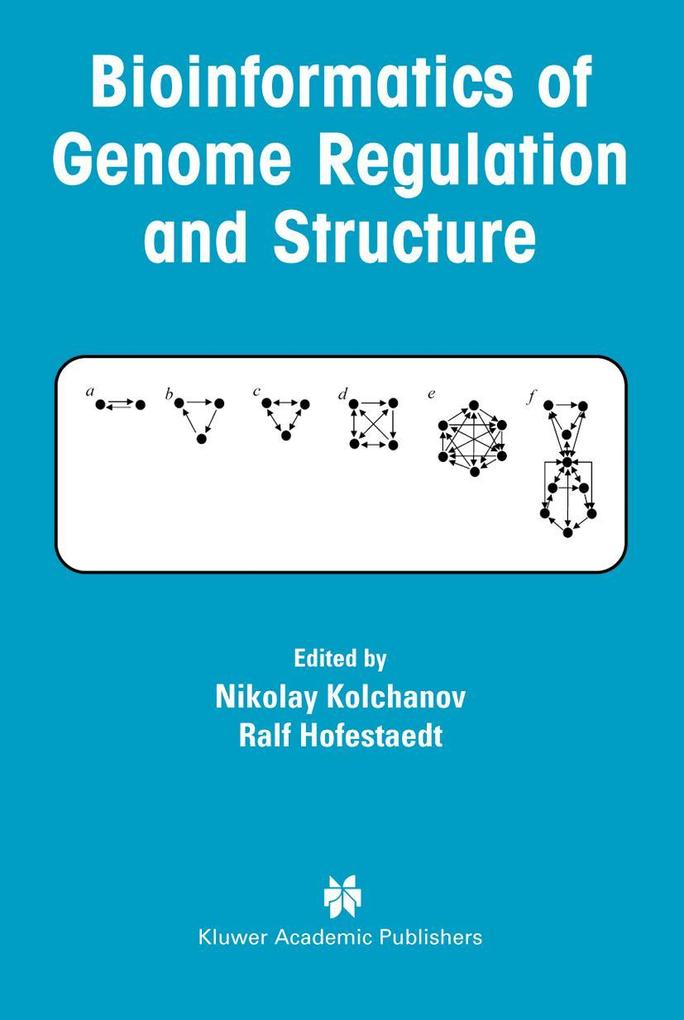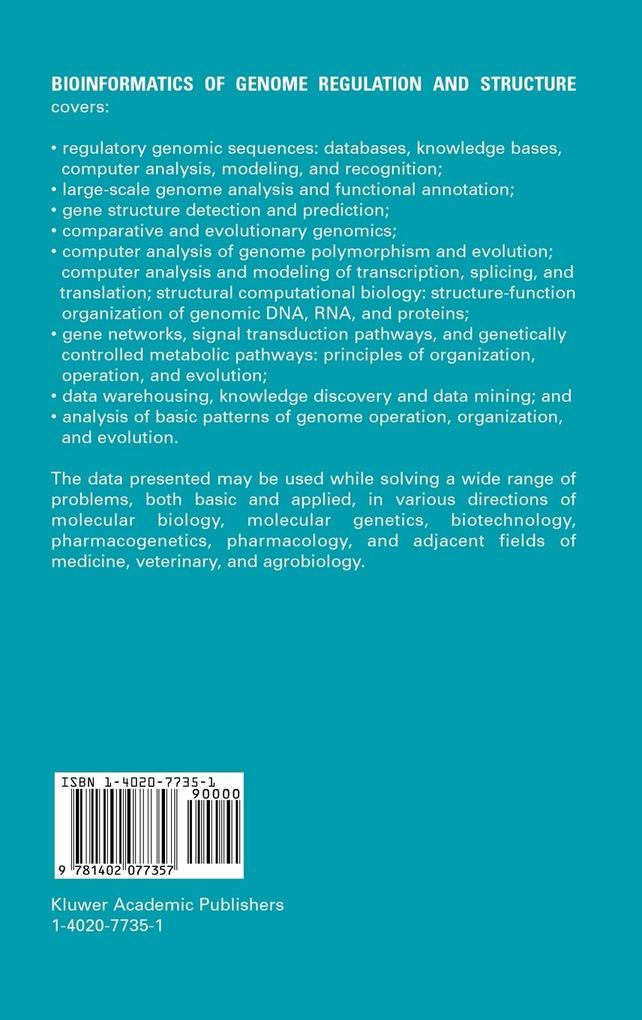
Zustellung: Sa, 07.06. - Do, 12.06.
Versand in 1-2 Wochen
VersandkostenfreiBestellen & in Filiale abholen:
Bioinformatics of Genome Regulation and Structure covers:
-regulatory genomic sequences: databases, knowledge bases, computer analysis, modeling, and recognition;
-large-scale genome analysis and functional annotation;
-gene structure detection and prediction;
-comparative and evolutionary genomics;
-computer analysis of genome polymorphism and evolution; computer analysis and modeling of transcription, splicing, and translation; structural computational biology: structure-function organization of genomic DNA, RNA, and proteins;
-gene networks, signal transduction pathways, and genetically controlled metabolic pathways: principles of organization, operation, and evolution;
-data warehousing, knowledge discovery and data mining; and,
-analysis of basic patterns of genome operation, organization, and evolution.
Inhaltsverzeichnis
1. Computational Genomics. - Nucleosomal DNA Organization: An Integrated Information System. - Using Change in Local DNA Sequence Complexity as a Pointer to the Mechanism of Mutagenesis in Inherited Disease. - Properties of Insertion Regions of Drosophila LTR Retrotransposons. - Compositional Asymmetries and Predicted Origins of Replication of the SaccharomycesCerevisiae Genome. - Revealing and Functional Analysis of tRNA-Like Sequences in Various Genomes. - Type-Specific Features of the Structure of the tRNA Gene Promoters. - Mathematical Tools for Regulatory Signals Extraction. - Argo_Viewer: A Package for Recognition and Analysis of Regulatory Elements in Eukaryotic Genes. - Transcription Regulatory Regions Database (TRRD): Description of Transcription Regulation and the Main Capabilities of the Database. - Sitecon A Tool for Analysis of DNA Physicochemical and Conformational Properties: E2F/DP Transcription Factor Binding Site Analysis and Recognition. - Local Secondary Structure May Be a Critical Characteristic Influencing Translation of Unicellular Organisms mRNA. - Computer Analysis of miRNA-mRNA Duplexes and Its Application to Predicting Possible Target mRNAS of Arabidopsis. - Correlations between Sequence Features of Yeast Genes Functional Regions and the Level of Expression. - 2. Computational Structural Biology. - Latent Periodicity of Many Domains in Protein Sequences Reflects Their Structure, Function, and Evolution. - Logical Analysis of Data as a Predictor of Protein Secondary Structures. - Structure-Specificity Relationship in Protein DNA Recognition. - Macromolecular Modeling as a Tool for Expanding Bioinformatics Databases. - Graphic Representation of Equilibrium and Kinetics in Oligopeptides: Time-Dependent Free Energy Disconnectivity Graphs. - Solvent Electrostatic Screening in Protein Simulations. - Pdbsitescan: A Program Searching for Functional Sites in Protein 3D Structures. - A Genetic Algorithm for the Inverse Folding of RNA. - Signal Transduction Pathways Initiated via Cell Surface Receptor CD150: In Silico and in Vitro Analysis. - 3. Computational Evolutionary Biology. - Study of the Specific Contextual Features of Translation Initiation and Termination Sites in Saccharomyces Cerevisiae. - Contribution of Coordinated Substitutions to the Constancy of Physicochemical Properties of ATP-Binding Loop in Protein Kinases. - Sporadic Emergence of Latent Phenotype during Evolution. - Similarity Analysis of Inversion Banding Sequences in Chromosomes of Chironomus Species (Breakpoint Phylogeny). - 4. System Computational Biology. - Integrative Analysis of Gene Networks Using Dynamic Process Pattern Modelling. - Development and Analysis of Models of Genetic and Metabolic Networks and Signal Transduction Pathways in the Genenet System. - Extension of Cell Cycle Gene Network Description Based on Prediction of Potential Binding Sites for E2F Transcription Factor. - Mathematical Simulation of Dynamics of Macrophage Gene Network Activated by Lipopolysaccharides and/or Interferon-g. - Computer Dynamic Modeling of the Gene Network Controlling Intracellular Cholesterol Homeostasis. - An Investigation of the Structural Stability of Drosophila Control Gene Subnetwork in Computer Experiments. - Modeling Plant Development with Gene Regulation Networks Including Signaling and Cell Division. - The Global Operation Modes of Gene Networks Determined by the Structure of Negative Feedbacks. - Statistical Analysis of Microarray Data: Identification and Classification of Yeast Cell Cycle Genes. - References.
Produktdetails
Erscheinungsdatum
31. Januar 2004
Sprache
englisch
Auflage
2004
Seitenanzahl
392
Herausgegeben von
Ralf Hofestaedt, Nikolay Kolchanov
Verlag/Hersteller
Produktart
gebunden
Abbildungen
XVI, 374 p.
Gewicht
752 g
Größe (L/B/H)
241/160/26 mm
ISBN
9781402077357
Entdecken Sie mehr
Bewertungen
0 Bewertungen
Es wurden noch keine Bewertungen abgegeben. Schreiben Sie die erste Bewertung zu "Bioinformatics of Genome Regulation and Structure" und helfen Sie damit anderen bei der Kaufentscheidung.











